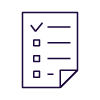How Paylocity put Employees First in “Employee Self-Service”—Including Employees with Disabilities
For organizations large and small, your employees are your business. Employees deliver your culture. Employees embody your ideals. Employees work in direct service of your corporate goals. How you treat and support them is critical to your success. Enter Paylocity—an HR and Payroll software built to help automate and enhance the employee experience. Offering employee self-service (ESS) solutions for paychecks, benefit elections, performance evaluations, recruitment, and more, there are few employer interactions that touch an employee’s personal satisfaction more directly. That’s why Paylocity is making strides to serve all your employees more equally, including people with disabilities.
An equitable employee experience
“At Paylocity, we believe everyone deserves equitable access to jobs,” says Paylocity Product Design Manager, Lorraine Smigielski. “When we make our employee self-service products accessible, we help our customers reach and retain the best talent, remove barriers to the workforce for people with disabilities, and make our software easier for everyone to use.”
With an estimated 1 billion people with disabilities worldwide1 and a growing number in the workforce2, the need to consider the digital accessibility of essential employee services is rising. Better accessibility not only minimizes barriers for people with disabilities but improves usability for all users—often making the user experience more intuitive, mobile and search friendly, and more easily used by the aging population. Prioritizing accessibility yields many benefits and is explicitly required to support the 26% of adult Americans with a disability today.3
To that end, Paylocity is reimagining its SaaS software experience with a complete design system overhaul—providing an opportunity to embed inclusive design standards from initial concept. Partnering with Level Access on wireframe and design reviews, user testing, development training, and evaluations, Paylocity is approaching employee self-service usability with accessibility as a core tenet in pursuit of a frictionless user experience.
Additionally, Paylocity champions a “Customer as Co-Creator” mentality and incorporates user feedback gathered from their product, online community, and engagement with key customers, like the School for the Blind, for targeted feedback on their products’ accessibility. Like Level Access’s user testing, feedback from such native users of assistive technologies is essential to validating a usable experience for people with disabilities and a lynchpin in their collaborative, people-first approach to product design.
“Accessibility and inclusion start way before product development or even planning for us. It starts with our company-wide commitment to serving everyone equally,” notes Smigielski. “We’ve created an inclusive company culture that has carried over into the products we produce.”
Inclusion for everyone
“Accessibility isn’t one person’s responsibility; it’s flourished for us as a total team effort with support from the top,” continues Smigielski. Paylocity is expanding awareness and support across the organization, aligning accessibility with the company’s Diversity, Equity, and Inclusion (DEI) efforts overseen by a cross-functional Diversity Leadership Council of director-level employees and above. The Council provides companywide education and mentorship as well as Employee Resource Groups (ERGs) for community building and unification of sub-cultures within the company. New ERGs, including a Disability Advocacy group, are slated for the new year.
Beyond general awareness, Paylocity offers additional opportunities for teams to further their technical accessibility skills. “We empower the people building our products to develop ongoing efficiency with accessibility best practices through Basic Training and Champions programs available to facilitate their continuous growth,” adds Smigielski. In addition to required training on basic accessibility concepts, team members across the Product and Technology teams are incented to continue learning in a gamified Champions program. UX designers, developers, quality assurance testers, and more earn points and rewards for expanding their understanding of topics like accessibility—a key element in the Quality Maturity Model used to benchmark product compliance for the team.
“What we love most about Level Access is the ability to create training curriculums for many different roles across our organization, not just developers and testers. A shared understanding of accessibility, its impact, and practice is key to sustaining our focus.” The team is also pursuing disability etiquette training for all employees to cement the importance of inclusion to the company culture.
Sustainability
“With Level Access, we’re now able to fully engage in conversations about inclusion and accessibility across all roles and departments within Paylocity,” closes Smigielski. Growing in internal know-how and sustainable best practices, Paylocity is poised to programmatically continue advancing on their corporate priorities: an inclusive company culture and an optimal HRMS ESS experience for all Paylocity users—including people with disabilities. “Accessibility requires ongoing effort but is morally and strategically the right thing to do to better serve our employees, our customer’s employees, and job seekers worldwide. We’re proud of the work we do with Level Access.”
Sources:
1 World Health Organization (WHO) Disability and Health Fact Sheet, 2021.
2 U.S. Department of Labor Bureau of Labor Statistics. Persons with a Disability: Labor Force Characteristics — 2021.
3 Center for Disease Control and Prevention (CDC) Disability Impacts Us All infographic, 2020.
Products used
-

Elevin Professional
Accessibility lifecycle management.
-

Access Advisor
On-demand consulting and support.
-

Access Academy
Online training program.
-

Testing & Audit Services
Evaluation and remediation strategy.

